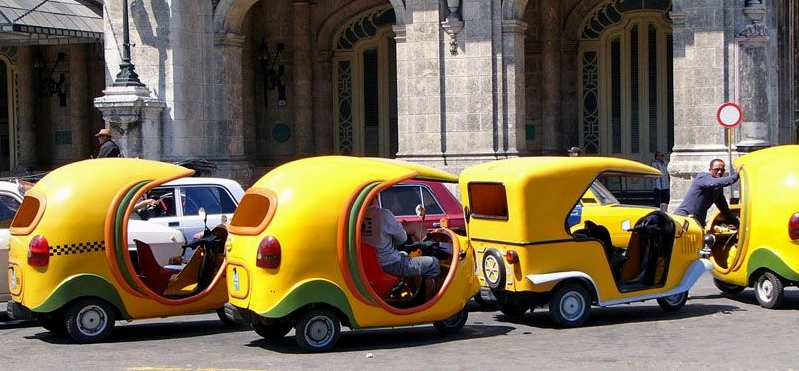While driving around in one of the Cuban vehicles, besides making friends with lovely and kind locals, I also met with a number of adventures. I’m an everyday driver, but I had a brand new experience on the Cuban roads.
I don’t like to be dependent on others, so I decided to rent a car to discover the island over the course of a month. If you don’t have a driving license, you can use public transport. Buses carrying tourists are modern, air-conditioned, and comfortable; but be prepared that they only run daily or 1-2 times a week. You have to make a plan in advance.
To initiate you into the mysteries of Cuba car rental would take a few more hours. Let’s just get familiar with the most unusual Cuban vehicles running on all types of roads from small mountain tracks through village paths to motorways.
The first thing that came to my mind when I saw Cuban vehicles was that Cubans were extremely creative. If someone has two old Lada cars, he’s likely to turn them into a limousine. (Lada is a Russian car brand from the AvtoVAZ manufacturer. In the Soviet period, this brand name was used only for export vehicles; the same models for the internal market were called Zhiguli.)
As I mentioned new, quality buses are available for point-to-point travel. Because of the ticket price locals can hardly afford to use these. They have an alternative of course. They convert trucks and lorries into buses. On most of them, there are no seats; they just jump into the back of the vehicle and sit down or travel standing.
There are luxury ‘buses’ with roofs and plastic chairs or wooden benches on them. Some of these are for ‘pregnant women only.’ Yes, they have buses running with only pregnant women on board!
If you travel around the capital, Havana camels can also get in your way. Not actual animals, Cubans call the long buses (usually built from two normal buses) camello. Try it if you dare. They are a bit old, out of fashion, noisy and slow, but you live once, be adventurous!

Another common form of transportation is the horse-drawn carriage. The ones running in the colonial streets of Havana (departing from Cathedral Square) are more stylish than those you’ll meet on the motorways.
If you decide to hit the road be aware of the following things: – the condition of motorways in Cuba is relatively poor, the average speed is 60 km/h you must bear this in mind when planning a longer trip – don’t forget to pack a detailed map and list of petrol stations and garages, service stations; signing boards may be taken by locals and re-used in a creative way – you will see speed limit boards in unexpected places, on the motorway; always observe the speed limit, there’s a good chance that a policeman is waiting nearby to charge you a nice fine – always stop if you see the railway-crossing sign on the motorway (no, I’m not crazy, you will see at least one), because it’s a sure bet that the policeman mentioned above is standing just behind the rails (it doesn’t matter if the rails are going nowhere; I mean they were cut at both sides of the road, you do have to stop; don’t ask why – you are in Cuba!)
It’s not always a disadvantage that you can’t go flat-out on motorways either. You can at least avoid possibly hitting a horseman or a complete cow herd crossing the road. It’s easy to avoid a collision with very slow motorcyclists, people riding bicycles, or traveling by strange kinds of vehicles.
Around cities, where rails were not cut and are still serviceable, small trains carry locals who have plenty of time. A family can fill the wagon, so most of the people have to search for other alternatives. Trains are air-conditioned by nature, meaning no doors or windows interfere in free airflow. A big advantage of this type of transportation is the stunning landscape; you have enough time on your journey to watch every palm tree go by.
I saved my favorite of the Cuban vehicles for last: Coco Taxis! They run in tourist areas and are driven by local drivers (who imagine that they are the new Fangios, Laudas, or Schumachers of the roads). Jump in and enjoy listening to the driver tell you his life story.

There is one other unusual activity I recommend in Cuba, Geocaching. If you haven’t heard of it before you can read about it here – Geocaching around the world. And for more travel ideas and advice take a look at my Facebook page – Travel by Petal.
Bio: This was a guest post.




I’m not that much of a internet reader to be honest but your sites really nice, keep it up! I’ll go ahead and bookmark your website to come back down the road. Cheers